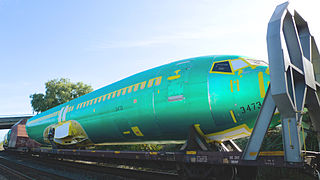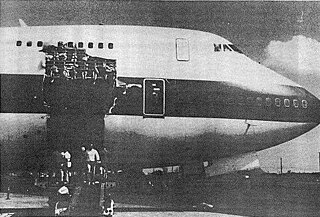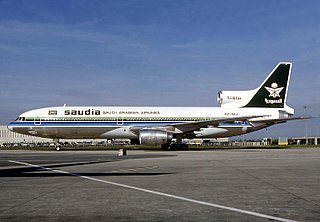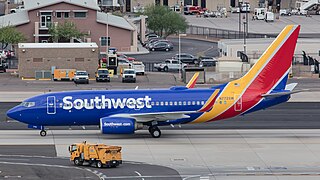
Turkish Airlines Flight 981 (TK981/THY981) was a scheduled flight from Istanbul Yeşilköy Airport to London Heathrow Airport, with an intermediate stop at Orly Airport in Paris. On 3 March 1974, the McDonnell Douglas DC-10 operating the flight crashed into the Ermenonville Forest, outside Paris, killing all 335 passengers, and 11 crew on board. The crash was also known as the Ermenonville air disaster. Flight 981 was the deadliest plane crash in aviation history until 27 March 1977, when 583 people perished in the collision of two Boeing 747s in Tenerife. It remained the deadliest single-aircraft accident until the crash of Japan Airlines Flight 123 on 12 August 1985, and the deadliest aviation accident without survivors until the Charkhi Dadri mid-air collision on 12 November 1996. It remains the deadliest single-aircraft accident without survivors, the second hull loss and the deadliest accident involving the McDonnell Douglas DC-10, the sixth deadliest aviation disaster altogether, and the deadliest aviation accident to occur in France. It is also the deadliest aviation incident that did not involve a Boeing 747.

Aloha Airlines Flight 243 was a scheduled Aloha Airlines flight between Hilo and Honolulu in Hawaii. On April 28, 1988, a Boeing 737-297 serving the flight suffered extensive damage after an explosive decompression in flight, caused by part of the fuselage breaking due to poor maintenance and metal fatigue. The plane was able to land safely at Kahului Airport on Maui. The one fatality, flight attendant Clarabelle "C.B." Lansing, was ejected from the airplane. Another 65 passengers and crew were injured. The substantial damage inflicted by the decompression, the loss of one cabin crew member, and the safe landing of the aircraft established the incident as a significant event in the history of aviation, with far-reaching effects on aviation safety policies and procedures.

Aviation safety is the study and practice of managing risks in aviation. This includes preventing aviation accidents and incidents through research, educating air travel personnel, passengers and the general public, as well as the design of aircraft and aviation infrastructure. The aviation industry is subject to significant regulation and oversight.
In aeronautics, a descent is any time period during air travel where an aircraft decreases altitude, and is the opposite of an ascent or climb.

British Airways Flight 5390 was a flight from Birmingham Airport in England for Málaga Airport in Spain. On 10 June 1990, the BAC One-Eleven 528FL suffered an explosive decompression. While the aircraft was flying over Didcot, Oxfordshire, an improperly installed windscreen panel separated from its frame, causing the captain to be partially ejected from the aircraft. He was held in place through the window frame for 20 minutes until the first officer landed at Southampton Airport.

American Airlines Flight 96 (AA96/AAL96) was a regular domestic flight operated by American Airlines from Los Angeles to New York via Detroit and Buffalo. On June 12, 1972, the left rear cargo door of the McDonnell Douglas DC-10-10 operating the flight blew open and broke off en route between Detroit and Buffalo above Windsor, Ontario; the accident is thus sometimes referred to as the Windsor incident, although according to the NTSB it is an accident, not an incident.

Cabin pressurization is a process in which conditioned air is pumped into the cabin of an aircraft or spacecraft in order to create a safe and comfortable environment for humans flying at high altitudes. For aircraft, this air is usually bled off from the gas turbine engines at the compressor stage, and for spacecraft, it is carried in high-pressure, often cryogenic, tanks. The air is cooled, humidified, and mixed with recirculated air by one or more environmental control systems before it is distributed to the cabin.

United Airlines Flight 811 was a regularly scheduled airline flight from Los Angeles to Sydney, with intermediate stops at Honolulu and Auckland. On February 24, 1989, the Boeing 747-122 serving the flight experienced a cargo-door failure in flight shortly after leaving Honolulu. The resulting explosive decompression blew out several rows of seats, killing nine passengers. The aircraft returned to Honolulu and landed without further incident.

Trans World Airlines Flight 840 was a regularly scheduled flight from Los Angeles to Cairo via New York City, Rome, and Athens on April 2, 1986. About 20 minutes before landing in Athens, a bomb was detonated on the aircraft while it was over Argos, Greece, blasting a hole in the plane's starboard side. Four passengers died after being blown out, while another seven were injured by flying shrapnel and debris. The aircraft then made a successful emergency landing with no further loss of life.

On October 25, 1999, a chartered Learjet 35 business jet was scheduled to fly from Orlando, Florida, United States to Dallas, Texas, United States. Early in the flight, the aircraft, which was climbing to its assigned altitude on autopilot, lost cabin pressure, and all six on board were incapacitated by hypoxia, a lack of oxygen in the brain and body. The aircraft continued climbing past its assigned altitude, then failed to make the westward turn toward Dallas over North Florida and continued on its northwestern course, flying over the southern and midwestern United States for almost four hours and 1,500 miles (2,400 km). The plane ran out of fuel over South Dakota and crashed into a field near Aberdeen after an uncontrolled descent, killing all six on board.

National Airlines Flight 27 was a scheduled passenger flight between Miami, Florida, and San Francisco, California, with intermediate stops at New Orleans, Louisiana; Houston, Texas; and Las Vegas, Nevada, United States.

Southwest Airlines Flight 2294 (WN2294/SWA2294) was a scheduled US passenger aircraft flight which suffered a rapid depressurization of the passenger cabin on July 13, 2009. The aircraft made an emergency landing at Yeager Airport (CRW) in Charleston, West Virginia, with no fatalities or major injuries to passengers and crew. An NTSB investigation found that the incident was caused by a failure in the fuselage skin due to metal fatigue.

Saudia Flight 162 was a scheduled flight from Dhahran International Airport, Saudi Arabia to Karachi International Airport, Pakistan that suffered a high-altitude uncontrolled decompression, above international waters off Qatar, killing two children who were among the 272 passengers.
Zonal Safety Analysis (ZSA) is one of three analytical methods which, taken together, form a Common Cause Analysis (CCA) in aircraft safety engineering under SAE ARP4761. The other two methods are Particular Risks Analysis (PRA) and Common Mode Analysis (CMA). Aircraft system safety requires the independence of failure conditions for multiple systems. Independent failures, represented by an AND gate in a fault tree analysis, have a low probability of occurring in the same flight. Common causes result in the loss of independence, which dramatically increases probability of failure. CCA and ZSA are used to find and eliminate or mitigate common causes for multiple failures.

Southwest Airlines Flight 812 was a Boeing 737-300 passenger jet that on April 1, 2011, suffered rapid depressurization while cruising at 34,000 ft (10,000 m) near Yuma, Arizona, leading to an emergency landing at Yuma International Airport. Two of the 123 people on board suffered minor injuries. The aircraft was operating Southwest Airlines' domestic scheduled service from Phoenix, Arizona, to Sacramento, California.

Southwest Airlines Flight 3472 was a regularly scheduled passenger flight operating from New Orleans International Airport in New Orleans, Louisiana to Orlando International Airport in Orlando, Florida. On August 27, 2016, the Boeing 737-7H4, with 99 passengers and five crew, 12 minutes after departure from New Orleans, was climbing through 31,000 feet and heading east over the Gulf of Mexico when the aircraft's number one CFM International CFM56-7 engine suffered an engine failure. A fan blade in the engine broke due to a fatigue crack. The separated portion of the blade rotated within the engine, moving forward, striking the engine inlet. Debris from the damaged engine inlet punctured the left side of the fuselage causing a loss of cabin pressure and damaged the wing and empennage. Oxygen masks were deployed to passengers while the crew initiated an emergency descent to 10,000 feet. The aircraft then diverted to Pensacola International Airport for a safe landing about 20 minutes later without further incident. While the aircraft sustained substantial damage, there were no injuries.

Southwest Airlines Flight 1380 was a Boeing 737-700 that experienced a contained engine failure in the left CFM56-7B engine after departing from New York–LaGuardia Airport en route to Dallas Love Field on April 17, 2018. The engine cowl was broken in the failure and cowl fragments damaged the fuselage, shattering a cabin window and causing explosive depressurization of the aircraft. Other fragments caused damage to the wing. The crew carried out an emergency descent and diverted to Philadelphia International Airport. One passenger was partially ejected from the aircraft and sustained fatal injuries, while eight other passengers sustained minor injuries. The aircraft was substantially damaged.

Alaska Airlines Flight 1282 was a scheduled U.S. domestic flight operated by Alaska Airlines from Portland International Airport in Portland, Oregon, to Ontario International Airport in Ontario, California. Shortly after takeoff on January 5, 2024, a door plug on the Boeing 737 MAX 9 aircraft, which was not bolted in place due to a manufacturing error, blew out causing an uncontrolled decompression of the aircraft. The aircraft returned to Portland for an emergency landing. All 171 passengers and six crew members survived the accident, with three receiving minor injuries. An investigation of the accident by the National Transportation Safety Board (NTSB) is ongoing. A preliminary report published on February 6 said that four bolts, intended to secure the door plug, had been missing when the accident occurred and that Boeing records showed evidence that the plug had been reinstalled with no bolts prior to initial delivery of the aircraft.

















